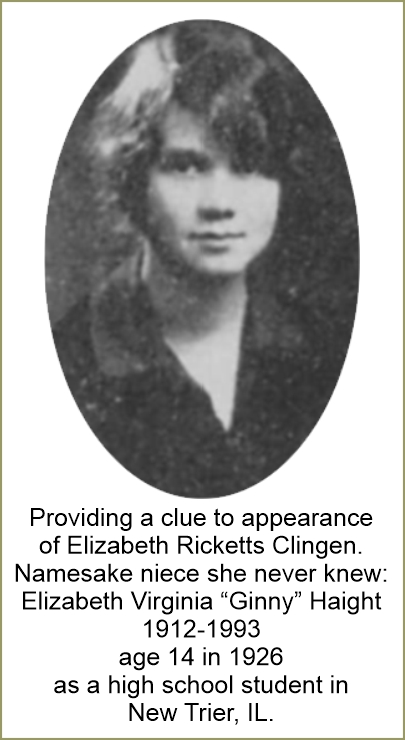|
Elizabeth
One of the most disturbing Iroquois Theater
fire stories. In researching this young girl's story I found myself
wishing for a last-minute rescue of a type seen in movies.
In the 2003 book Tinderbox, author Anthony Hatch relates a story told
to him in 1961 by a retired Chicago fireman who was among first responders
at the Iroquois. Eighty-nine-year-old Michael J. Corrigan (1872-1966)
described receiving a surprise while working to remove the dead from the
Iroquois theater.
As painting contractors had done, Chicago
firemen made a bridge of a ladder stretched from the dental department at
Northwestern University to
door
#37 at the Iroquois. That door led from the back of the third-floor
balcony to the eastern-most fire escape. A majority of the audience in the
third-floor gallery had converged in the standing room area behind the
seats. There were masses of victims on the south side at the doors leading
to the lobby (door nos 38 & 39) and on the north side at the doors leading
to the fire escapes (door nos 35-37). When the fireball hurled from the
stage into the auditorium, most died instantly. Feet and legs held partly
upright, rooted in the densely packed crowd, upper bodies fallen sideways
haphazardly. Several first responders described the arrangement of bodies as
looking like Timothy grass.

Interior stairwells and balcony doorways were piled
high with victims, impeding fire fighter's access. To put out the last of
the fire and search for survivors, firemen had to clear a path through the
bodies. Some were dropped to the ground sixty feet below. Over a hundred
were carried across the ladder to Northwestern.
As the firemen worked amidst hundreds of dead, a semi-clad girl, blackened
with burns and soot, rose specter-like from between the rows of seats.
According to Corrigan, she ran toward the fire escape exit and across the
ladder into Northwestern, firemen chasing after her with a blanket.
I have no doubt that girl was thirteen-year-old* Elizabeth "Bessie"
Ricketts Clingen (b.1890). While she may have run toward the open door, and
whatever dim light and cold air streamed through it, she did not run across
a narrow plank. Bessie was sightless, her eyes destroyed by the fire.
Elizabeth's eventual obituary, on February 11, 1904, contained discrepancies
depending upon the newspaper — one reporting she was found beneath a pile of
bodies and another beneath the seats. All reports agreed she
was carried across a plank to Northwestern by firemen. Walking across a
twenty-foot plank sixty feet off the ground would take great courage. Doing
it while carrying a body is the stuff of heroes.
Elizabeth's later obituary reported she attended the theater with two
companions, with no mention of their identities or if they survived. I kept
delving and learned that one of the companions was Elizabeth's younger
sister, twelve-year-old Margaret Edith "Effy" Ricketts Clingen (1891-1918).
I suspect the third party member was the girls' mother, for whom Elizabeth
was named, Elizabeth Caroline Bowen Clingen, and that she escaped from the
theater with the younger child, Margaret.
Then came Grandma Lizzie
At the time of the 1900 census, and until
1901, Elizabeth and and her sister lived with their grandparents in Decatur,
IL, 180 miles southwest of Chicago. The grandparents were William L. Newman
(1838-1914) and Pennsylvania native, Kate "Lizzie" E. Shank Bowman Newman
(1850-1940). By 1903 the sisters were living in Chicago with their mother and
stepfather and used their stepfather's name, Clingen, instead of their birth
name, Ricketts. It was a common practice of the time for children to assume
a stepfather's name, without evidence of a legal adoption procedure. When a
man married, his wife and her children became his property.
William Clingen's failure to immediately cable the Newman grandparents with
the sorry news of their granddaughter's hospitalization is understandable.
The girls were in two different hospitals and he did not locate Elizabeth
until the day after the fire. It is not known when Margaret was released
from the hospital. If their mother was also at the theater, nothing is known
of her condition.
William had an additional reason to do some foot-dragging in contacting his
mother in law. He had agreed with a decision of his wife, a devout Christian
Scientist, that was sure to incur Lizzie's wrath. They'd removed Elizabeth
from the hospital and turned her care over to a faith healer. They believed
God would do what was best for Elizabeth. As it happened, Lizzie Newman had
also been communing with God and asserted the book she was writing on the
subject of Satan's involvement in Christian Science and faith healing was at
His direction. Elizabeth became caught in her family's contradictory
interpretations of God's will.
Lizzie accepted the inevitability of her granddaughter's death but condemned
her daughter for preventing Elizabeth from taking medication that could
relieve her pain.
Read more about Lizzie below.
|

|
More details about Elizabeth's rescue
Elizabeth and her companions were seated or standing in the third-floor
balcony. As the audience fought to reach safety, Elizabeth fell to the
floor.
Surrounded by seats and/or, depending upon the
obituary, layered beneath other people, she was somewhat protected from the
fireball. Enough to survive while many others perished at the scene, but not
enough to prevent mortal injuries.
Elizabeth was transported to the
Passavant Hospital
where she was probably given opioids during the most painful first hours,
before her mother could interfere. Reportedly Elizabeth's stepfather,
William C. Clingen, heard about the fire and reached the front doors of the
Iroquois Theater about the same time that Elizabeth was being rescued.
Elizabeth tried to conceal her pain from her mother
Passavant physicians did what they could for Elizabeth but advised the
parents that their daughter would not survive. One obituary said Elizabeth
insisted upon going home the second day. Since newspaper reports also noted
she accommodated her mother's belief in faith healing, her interest in
leaving the hospital may have been motivated by a wish to please her mother.
To physicians, she privately confessed that the pain was awful. Her burns
probably varied from second to third degree, the worst injuries at the
extremities. Since she was not expected to live, treatment would have been
limited to pain management. The areas with least nerve damage were probably
the most painful.
Skin on ears and toes sloughed away
Elizabeth was initially taken to her home at
291 Ashland Blvd. For the next forty days the teenager received no
medication. Her burns were treated with olive oil† and she was told her pain
did not exist, that she would recover if she put her faith in God.
Elizabeth's suffering hidden from protesting neighbors and authorities
Pressure came from neighborhood nurses and the health
department to re-hospitalize the girl. They may have been alerted by
Elizabeth's screams, as were the neighbors of another Iroquois victim, who
had received pain killers, whose screams could be heard in neighboring
homes. Elizabeth's parents transferred her to a so-called hospital that was
a former laying-in home for pregnant women, operated without physicians, by
a Christian Science midwife who had no training in caring for burn
victims.
Like moving her from the Passavant Hospital, the decision to be moved away
from her home, was attributed to Elizabeth. (Read more
about her care below.)
Elizabeth's parents
Stepfather William C. Clingen (1862-) was from
Detroit. Her mother, also named Elizabeth, (by the end of her life her full
name being Elizabeth Caroline Bowen Ricketts Clingen and nicknamed Bessie
and Effie (1872-1959), was from Iowa. They had married in 1899 in Milwaukee,
WI. William was Bessie's second husband. In 1894 she divorced her first
husband, Elizabeth and Margaret's father, butcher Harry J. Ricketts
(1869-1913), citing adultery and extreme cruelty.
In the years after the fire
By 1908 William and Bessie lived in Lake
Bluff, Illinois, where he invented and patented a fireless cooker. They
eventually divorced. In 1920 William remarried divorcee Lina Plumer Wamboldt.
Bessie left the Christian Science faith and became a
Moravian.
Grandmother Lizzie and William Newman lived in Joplin, Missouri at the end of
 their lives.
I found nothing to indicate whether there was a reconciliation between Lizzy
and her daughter or whether Margaret Ricketts Clingen joined the Christian
Science faith as an adult. their lives.
I found nothing to indicate whether there was a reconciliation between Lizzy
and her daughter or whether Margaret Ricketts Clingen joined the Christian
Science faith as an adult.
Elizabeth's younger sister, Margaret Edith Ricketts Clingen, attended Parsons college, married Abram Van Voorhis Haight
II. They had two children and lived in
Evanston, Illinois when she died in 1918 at age twenty-seven. She
named her daughter after her mother and late sister: Elizabeth Virginia Haight (1912-1993).
Nicknamed Ginny, the daughter participated in basketball and volleyball, in the
orchestra and school newspaper, and in the drama club, acting in four plays
one year. The accompanying picture might be the only clue as to the
appearance of her aunt Elizabeth Rickets Clingen. |
